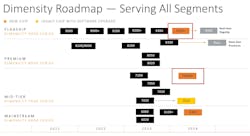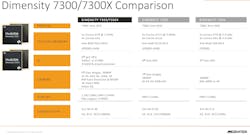Mobile SoC Platform Incorporates Generative AI Acceleration
What you’ll learn:
- The Dimensity 9300+’s large-language-model (LLM) capability.
- New chips in the Dimensity product family.
The Dimensity 9300+ platform developed by MediaTek builds on the artificial intelligence/machine learning (AI/ML) of the Dimensity 9300 while including features like ray-tracing support from the earlier Dimensity 9200. I talked with Finbarr Moynihan, MediaTek’s Vice President of Corporate Marketing, about the company’s latest chip (see the video above).
The same third-generation, TSMC 4-nm (N4P) process is utilized with the Dimensity 9300+ (Fig. 1). The new generative AI hardware acceleration can handle up to 7 billion parameters, putting it on the edge for mobile devices like high-end smartphones. It can process 22 tokens/s and includes support for speculative decode and ZipLoRA. It also supports Google’s DeepMind Gemini Nano and Meta’s Llama2 ExecuTorch.
The Dimensity 9300 family LLM support enables applications like the VIVO X100 Pro and Real-time Assistant for the Visually Impaired to run on mobile devices (Fig. 2). LLMs help deliver features like text-to-image, -speech, and -music as well as image-to-image transformations for photo editing and video streaming.
The main Arm Cortex-X4 in the Dimensity 9300+’s octal core has been bumped up to 3.4 GHz while the remaining Cortex-X4 and Cortex-A720 cores operate at the same frequency as the Dimensity 9300. The Dimensity 9300+ is at the top of MediaTek’s food chain (Fig. 3), which also includes new 7300 and 6300 chips.
The 7300 is also based on the 4NP process. Its octal processing system uses four 2.5-GHz Arm Cortex-A78 cores and four Cortex-A55 cores (Fig. 4). The GPU is an Arm Mali G615 MC2. AI/ML acceleration is provided by a sixth-generation APU. This midrange mobile platform supports 2x2 Wi-Fi 6E along with 5G support. The 7300X target flip phones that support a 120-MHz, 1.5K retina (1300 × 2760 pixels) display.
About the Author
William G. Wong
Senior Content Director - Electronic Design and Microwaves & RF
I am Editor of Electronic Design focusing on embedded, software, and systems. As Senior Content Director, I also manage Microwaves & RF and I work with a great team of editors to provide engineers, programmers, developers and technical managers with interesting and useful articles and videos on a regular basis. Check out our free newsletters to see the latest content.
You can send press releases for new products for possible coverage on the website. I am also interested in receiving contributed articles for publishing on our website. Use our template and send to me along with a signed release form.
Check out my blog, AltEmbedded on Electronic Design, as well as his latest articles on this site that are listed below.
You can visit my social media via these links:
- AltEmbedded on Electronic Design
- Bill Wong on Facebook
- @AltEmbedded on Twitter
- Bill Wong on LinkedIn
I earned a Bachelor of Electrical Engineering at the Georgia Institute of Technology and a Masters in Computer Science from Rutgers University. I still do a bit of programming using everything from C and C++ to Rust and Ada/SPARK. I do a bit of PHP programming for Drupal websites. I have posted a few Drupal modules.
I still get a hand on software and electronic hardware. Some of this can be found on our Kit Close-Up video series. You can also see me on many of our TechXchange Talk videos. I am interested in a range of projects from robotics to artificial intelligence.




